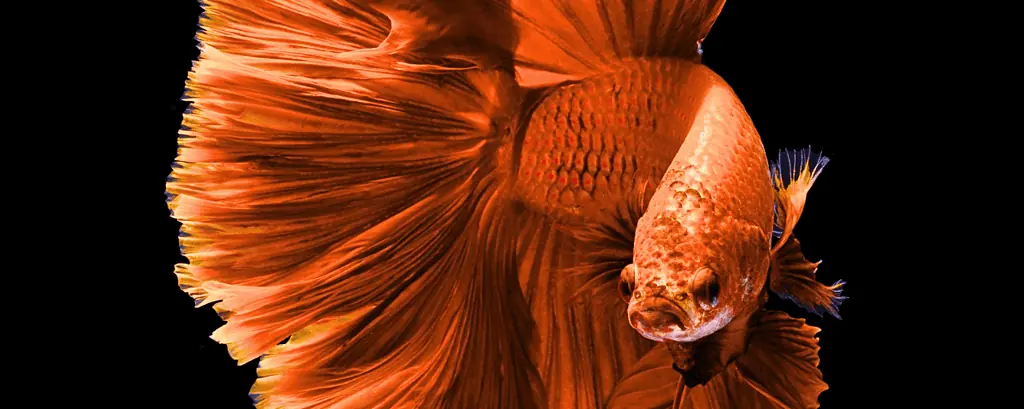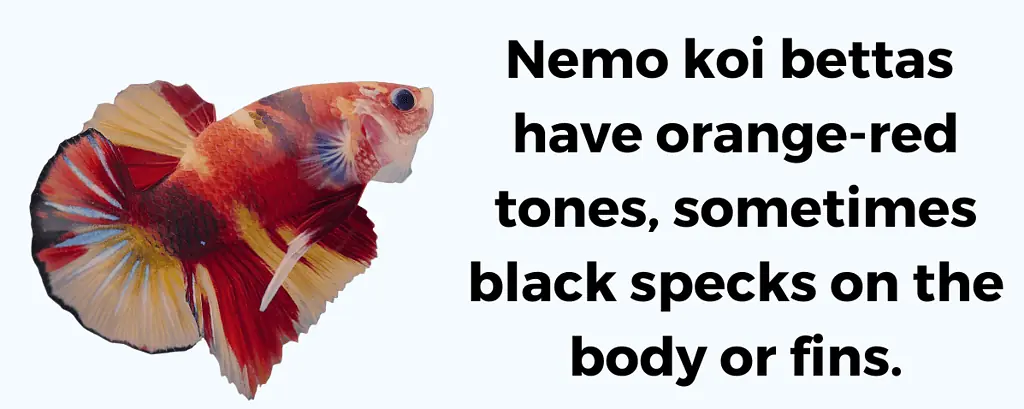The wide variety of bright colors in betta fish makes them one of the most popular choices for home aquariums.
Different shades of red and blue are quite common in bettas.
But you won’t find very many orange betta fish.
Orange bettas have complicated genetics, and few breeders specialize in them.
Let’s dive into the orange betta’s unique genetics and discover what makes this fish so special.
Table of Contents
What Is an Orange Betta Fish?

Orange betta fish range in hue from super bright to pale pastel.
The ideal coloration of these fish is a deep pumpkin color with very little black scaling.
Some orange betta fish have random red, yellow, or black spots.
Orange bettas may have streaks of iridescence in their fins, but this is rare.
These beautiful fish can have any tail type available in bettas.
But the halfmoon and crowntail are the most common in orange bettas.
Color Variations in Orange Betta Fish
Orange betta fish do not always breed true because of their complex genetics.
This has led to the creation of new patterns through selective breeding.
Since orange bettas are a more recent development, there are few color variations.
Orange Dalmatian

Many betta enthusiasts seek out this color variation due to its rarity.
An orange Dalmatian betta has a pale orange coloration with reddish-orange spots on its fins.
These spots vary in size and appear in a random pattern.
Even though there are several ways of achieving this color pattern, the results are not reliable.
Breeding two orange Dalmatian bettas does not produce orange Dalmatian offspring.
You must breed an orange Dalmatian betta with a solid orange betta for a chance of orange Dalmatian offspring.
Some experienced breeders have succeeded by breeding a solid orange betta with a red dragon betta.
Another method of achieving orange Dalmatian offspring is by breeding a melano (black) betta with a yellow betta.
But this method takes three generations for the desired results.
The first generation produces only multi-colored bettas.
Breeding offspring from the first generation can produce a few orange Dalmatian bettas.
Continuing this line into the third generation produces mostly orange Dalmatian offspring.
Orange Koi

The orange koi betta has an orange body with white and black spots. The colors appear in the pattern of a traditional Japanese koi fish.
There is a lot of debate over whether orange koi bettas are the result of marble genes.
Many betta enthusiasts believe the koi pattern is the result of marble genes.
This means the betta can change colors throughout its life.
Others say the koi pattern is fixed, making the coloration permanent.
But betta breeders generally believe that the koi pattern results from marble genes.
Koi bettas include other variations with the same pattern.
The galaxy koi betta has the traditional koi pattern with spots of iridescence.
Male galaxy koi bettas usually have less iridescence than females.
One of the rarest koi betta varieties is the Nemo koi betta.
Nemo koi bettas are mostly orange and red. They may have black specks on the body or fins.
The orange samurai koi betta is the rarest koi pattern.
Orange samurai koi bettas have the marble koi pattern with dragon scales.
Between 40% to 70% of the betta’s body has dragon scales.
Do Orange Betta Fish Exist in the Wild?

Wild betta fish species come in a variety of colors, including orange.
The most well-known orange wild betta species is the betta Macrostoma.
This betta fish species was first discovered in the early 1930s. However, it was not officially recognized until 1953.
Due to the destruction of its natural habitat, the betta Macrostoma is classified as an endangered species.
Captive breeding programs are now in place for the preservation of the species.
The male betta Macrostoma has a bright orange body coloration with short, rounded fins.
This species is also called the Spotfin betta because of the orange and black spots on the dorsal fin.
Its caudal fin has black and orange stripes, while the anal fin is dark orange with a black edge.
The most distinguishing feature of the betta Macrostoma is its large mouth.
Are Orange Betta Fish Rare?

Orange bettas are rare, and you won’t find them in your local pet store.
You may have better luck finding an orange betta fish from a breeder online.
Many online breeders sell multi-color orange betta variants.
But there are several who specialize in solid orange bettas, as well.
The Average Cost of an Orange Betta Fish

The average cost of an orange betta fish ranges from $12 to $65 or more.
Solid orange and female bettas are the least expensive.
Rare orange bettas color varieties like the orange Dalmatian and the orange samurai koi have the highest price tags.
Shipping costs from online breeders range from $15 to $40.
When given a choice, overnight shipping is your best option. It is more expensive, but it ensures your fish arrives fast.
Bettas can become very stressed during shipping. This stress sometimes leads to serious health issues or even death.
The less time your betta spends in transit, the better.
The Breeding History of the Orange Betta Fish

The origin of the domestic orange betta splendens is unclear.
It was likely discovered by accident due to a genetic variation called the non-red gene.
The non-red gene removes red pigments, allowing for yellow and orange colorations.
There are two types of non-red genes. The “nr1” results in yellow bettas, and the “nr2” produces orange bettas.
Non-red genes are recessive to the extended red and reduced red genes.
Captive betta splendens have four color layers:
- Iridescent (Top)
- Black
- Red
- Yellow (Bottom)
In wild bettas, the black and red layers are swapped.
Betta fish must have the right combination of pigment cells on each color layer for the appearance of orange coloration.
The orange color can come from both parents carrying the nr2 gene or a possible mutation of the extended red gene.
Orange betta fish may also have Cambodian and blonde genes on the black color layer.
Breeding two orange bettas usually results in orange offspring.
However, breeding orange offspring from the same line can result in a washed-out color after several generations.
Crossing a solid orange betta with a black and orange betta can help maintain the color intensity of the offspring.
Maintaining the Color of Your Orange Betta Fish

When bettas become sick or stressed, their colors can fade.
A betta regains its bright colors after recovering from illness or acclimating to a cleaner environment.
Bettas also lose some of their color as they get older. This is normal, and there is no way of reversing this color change.
Help your orange betta maintain its bright color with a nutritious diet and a healthy environment.
Diet
A varied diet of protein and essential nutrients can help your orange betta keep its bright color.
High-quality betta pellets, like these from Amazon, have natural color-enhancing ingredients.
Protein-rich foods like brine shrimp and blood worms also brighten the color of your orange betta.
Tank Conditions

Poor water quality can make your orange betta stressed and sick, resulting in paler colors.
Keep your tank water clean with the help of:
- Beneficial bacteria
- An aquarium filter
- Weekly partial water changes
Tank temperatures are also important for your betta.
Colder water temperatures can weaken your betta’s immune system and cause digestive issues.
Maintain a stable temperature range between 78-80 degrees Fahrenheit with an aquarium heater.
Here’s our guide on maintaining the water for your betta.
Bettas also need more space than a standard fish bowl provides.
Cramped conditions cause stress in bettas, and small betta bowls are harder to keep clean.
Choose a tank size of at least 5 gallons or more for your orange betta.
Environment

It may sound strange, but betta fish adjust their color according to their environment.
A dark background can make your orange betta brighter.
Consider using a dark-colored substrate or adding a black background to your orange betta tank.


